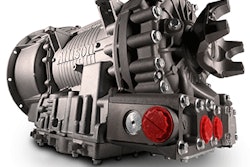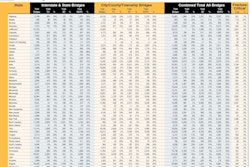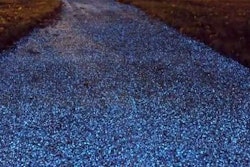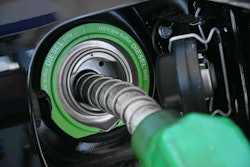Processing and storage makes reclaimed asphalt pavement and recycled concrete aggregate useful as aggregate.
By Tom Kuennen, Contributing Editor
In the past two decades, reclaimed asphalt pavement (RAP) and recycled concrete aggregate (RCA) have taken their places among materials commonly used for roadbuilding.
There is no stopping the growth of recycled and reclaimed materials in construction – not just road construction – and thoughtful processing of reclaimed materials results in high-quality RAP and RCA for reuse in pavements, road bases, fill and foundations.
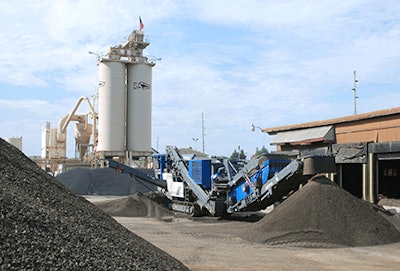 Raw RAP stockpile (foreground) is reduced to consistent sizes by a mobile impact crusher.
Raw RAP stockpile (foreground) is reduced to consistent sizes by a mobile impact crusher.Use of RAP and RCA is growing dramatically as road agencies accept them more and more in their specs. But because RAP and RCA come from a variety of sources, they must be processed – “fractionated” – and characterized prior to use in mixes as an engineered, value-added product.
Recycled materials producers and asphalt mix providers must produce recycled aggregates – and maintain stockpiles – as diligently as they do virgin materials.
There’s a reason for it.
When RAP and RCA are treated like virgin aggregates in the yard – being crushed, screened, tested, blended, protected and tested again – they can be used reliably in pavement mixes and road bases as engineered aggregates.
Fractionating RAP for mix design
One way to boost use and consistency of RAP for mixes is for hot-mix asphalt (HMA) producers to maintain sheltered, blended RAP stockpiles and, if needed, reprocess or fractionate RAP into individual gradations. Sheltered stockpiles are favored because RAP absorbs water more easily than virgin aggregates.
“Fractionation of RAP is a huge advantage for mix design,” said National Center for Asphalt Technology (NCAT) director Randy West, P.E., in a 2009 presentation to the Minnesota Department of Transportation (DOT). “It allows RAP to be used in practically any mix type.”
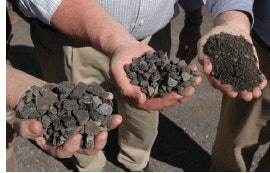 Raw reclaimed asphalt pavement (RAP) awaits fractionation to clean, screened sizes
Raw reclaimed asphalt pavement (RAP) awaits fractionation to clean, screened sizes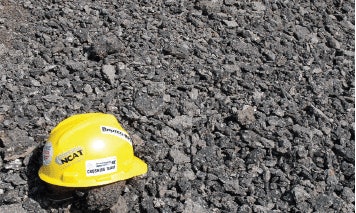
Fractionation is the processing and separation of raw RAP into at least two sizes, typically a coarse fraction (+1/2 or +3/8 inch) and a fine fraction (-1/2 or -3/8 inch). Many states allow higher amounts of RAP if it has been fractionated, reports Audrey Copeland, National Asphalt Pavement Association (NAPA) director of engineering. For example, in the Texas specification, she says, unfractionated RAP is limited to 10, 20 and 30 percent by surface, intermediate and base layers, respectively. However, by special provision, fractionated RAP is allowed at up to 20, 30 and 40 percent in those same layers.
One problem with RAP is its composition varies because it’s sourced from a wide variety of locations. Therefore, advance knowledge of the composition of the residual binder in RAP – along with the separate stockpiling of different varieties, or blending of varieties to create a consistent product – is necessary for creation of reliable mixes.
Mobile impact crushers are ideal for producing large volumes of screened or fractionated RAP or RCA on a relatively small footprint in the plant.
Impactors are best suited for RAP and RCA because they break up chunks of asphalt [or concrete] pavement or agglomerations of RAP, rather than downsize the aggregate gradation. Compression-type crushers such as jaws and cones tend to clog due to packing (caking) of RAP when the RAP is warm or wet, according to NCAT. Both impactors and jaws are suitable for RCA processing.
Recycled concrete aggregate also must be crushed, screened, tested and stored in blended stockpiles to ensure consistency. Contaminants may be encountered during processing demolition concrete, such as soil and organic detritus, and reinforcing steel, dowel and tie bars.
Here, crushers used with prescreens or grizzlies benefit because dirt and fines are removed before they ever enter the crushing circuit, preventing equipment wear, saving fuel and possibly creating a salable fill byproduct. High-performance rebar magnets should have a maximum discharge capacity, with the ability to be hydraulically lifted or lowered to accommodate larger sizes of rebar if present in the latest load of demolition concrete.
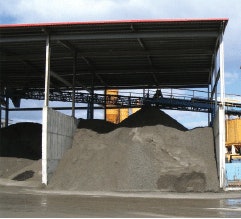 Processed RAP stored under cover absorbs less moisture, requiring less heat in the drum plant when incorporated into mix.
Processed RAP stored under cover absorbs less moisture, requiring less heat in the drum plant when incorporated into mix.Although most RAP or RCA processing equipment is permanently mounted on concrete pads, mobile-tracked crushers permit recycled material producers to relocate piles while continuing to ship, removing RCA or RAP from existing piles while creating new ones and improving traffic flow, all while eliminating the need to move a stockpile with loaders or other equipment.
Creating separate RAP stockpiles from different milling jobs is recommended because multiple sources may be subject to more rigorous testing than RAP from a single source. For all RAP stockpiles, the asphalt binder content and aggregate gradation must be determined, which may be decided according to AASHTO T308 or AASHTO T164. The most common method for determining the asphalt cement in a sample of RAP is to use the ignition-oven method specified in AASHTO T308.
A different challenge with RCA
Production of RCA poses a different challenge. Processing of RAP usually takes place at an asphalt plant, but RCA processing often takes place at the demolition contractor’s equipment yard or via a portable plant set up at the demolition site. The stockpiled, processed recycled concrete aggregate is sold directly by the demolition contractor, either from his yard or from the jobsite. The material is neither tested to determine its chemistry or mortar content nor rigorously screened to remove dirt or deleterious material.
“Concrete pavement recycling is a viable, successful and proven technology,” says Mark B. Snyder, Ph.D., P.E., vice president of the Pennsylvania Chapter of the American Concrete Pavement Association (ACPA). “However, RCA must be treated as an engineered material and not as a straight-up replacement for natural aggregate. The properties of recycled concrete aggregate can vary greatly, depending on the original aggregate source and the production techniques. Therefore, it’s necessary to characterize the material so it’s used properly.”
In particular, the physical and mechanical properties of RCA vary with the quality and quantity of reclaimed mortar, which may affect the design of the structure or concrete mixture. These effects can be significant when maximizing reclamation efficiency by including lots of mortar or minimal when efforts are made to eliminate as much reclaimed mortar as possible.
RCA is composed of virgin aggregates and mortar (cement paste, sand, air and admixtures). The crushing process results in aggregate particles that are often more angular and rough than typical virgin aggregates, and their properties are somewhat different. RCA typically has a higher absorption capacity, lower specific gravity, greater mass loss in tests such as L.A. abrasion and higher chloride content than virgin aggregates, reports the ACPA.
Nonetheless, the ACPA says RCA aggregates typically must (and generally do) meet the same requirements as virgin aggregates for the target application, even if the RCA is produced from a concrete pavement with a materials-related distress such as D-cracking or alkali-silica reactivity (ASR).
The mortar content of the final RCA product is a key to a successful application. Crushed concrete will reduce to either large-size coarse aggregate particles or smaller mortar particles, composed of cement paste plus sand particles and fly ash or any other admixture.
How much mortar should come off the RCA depends on the ultimate use of the RCA. Again, the RCA needs to be tested and treated as an engineered material. Some types of crushing processes will remove less mortar, but then the presence of added mortar will have to be taken into account in designing the application.
The other end of the spectrum is reclaiming less material while producing an RCA that is as close to natural aggregate; for that, an impact crusher will remove as much mortar as possible.
Stockpile management with RAP
Good materials management practices should always be part of the quality-control program for any asphalt mix production operation, says NCAT’s West. “As RAP contents increase, it becomes more important to accurately determine properties of RAP and control its consistency,” he adds.
Sadly, while dirt and trash are a common component of demolition concrete submitted for recycling, it can be a problem with RAP as well. In his 2010 draft technical paper, Reclaimed Asphalt Pavement Management: Best Practices, West suggests keeping dirt and trash out of RAP stockpiles.
“It is easy to understand how bad perceptions of RAP form when there is dirt, rubbish or vegetation in RAP stockpiles or when trash is found in the mix when it shows up on the job site or pops out of the pavement a few days after paving,” West says. “Treat RAP stockpiles as the most valuable material on the plant yard, because they are.”
RAP management should begin with a basic inventory analysis of the available RAP and future mix production, West says. This analysis is important to establish realistic goals for how much RAP can be used at a particular plant. The analysis includes the following steps:
• An inventory of RAP on hand and RAP generated per year
• A summary of mix produced per year by mix types and customers
• Determination of the maximum amount of RAP that can be used
• A comparison of the quantity of RAP available to the amount of RAP needed.
When stockpiling RAP, West recommends not building steep stockpiles; this promotes segregation of sizes as large particles roll down the sides to the bottom. “Building steep sided stockpiles will create segregation within the pile,” West said in a 2009 presentation for the Minnesota DOT. As RAP tends to retain moisture, requiring more burner energy in the drum, he suggests minimizing moisture in RAP by using covered stockpiles with a sloped pavement beneath.
Equipment optimizes RAP
New designs of portable and stationary recycle systems can enhance the cost-efficiency of asphalt plants while furnishing a finished product that maintains the high quality of a pure virgin aggregate mix, but with the cost savings of RAP.
Asphalt Drum Mixers Inc.’s recycle bins feature a 15-ton capacity and are continuously welded at the seams. The bins contain angle irons and midsection stiffeners for reinforcement, and their steeply sloped sidewalls prevent material from plugging or bridging. A tapered discharge opening leads to the direct-drive belt feeder with a 5-horsepower motor, multi-ply belt, self-cleaning tail pulley and adjustable skirt boards.
To transfer RAP from the bin, the recycle system includes a heavy-duty weigh conveyor that features a channel frame and wind shroud protection for accurate weighing. The conveyor is 2-feet wide and, depending on the model, between 45- and 65-feet long. It introduces RAP to the dried aggregate mix after the heating process. Based on conditions and type of plant, up to 50 percent of the HMA can contain recycled pavement.
An optional lump breaker is available for ADM’s recycling systems to break down large pieces of RAP into a usable size. It has an adjustable steel breaker plate, replaceable tungsten-tipped teeth and is powered by a 30-horsepower, high-efficiency motor with an open-mesh covered V-belt drive. Single- and double-deck scalping screens are available so oversized material doesn’t enter the aggregate mix. Other options include air cannons, grizzlies, bin extensions, adjustable legs with sand shoes and a skid with bolt-on support legs.
Web Extra: Read “Optimizing Use by Processing” at www.BetterRoads.com.




